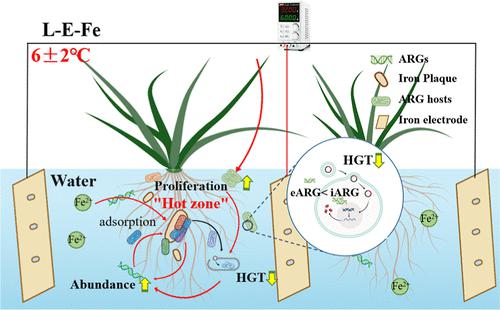当前位置:
X-MOL 学术
›
ACS ES&T Eng.
›
论文详情
Our official English website, www.x-mol.net, welcomes your
feedback! (Note: you will need to create a separate account there.)
Occurrence and Composition Patterns of ARGs in Plant-Microbial Synergism Were Negatively Reconstructed by an Electrochemical Technology at Low Temperatures
ACS ES&T Engineering ( IF 7.4 ) Pub Date : 2024-01-03 , DOI: 10.1021/acsestengg.3c00362 Na Zhang 1, 2, 3 , Maozhen Han 3 , Xiaohui Liu 1, 2 , Ying Liu 4 , Shaoyong Lu 5 , Fengmin Li 1, 2 , Fengchang Wu 5
ACS ES&T Engineering ( IF 7.4 ) Pub Date : 2024-01-03 , DOI: 10.1021/acsestengg.3c00362 Na Zhang 1, 2, 3 , Maozhen Han 3 , Xiaohui Liu 1, 2 , Ying Liu 4 , Shaoyong Lu 5 , Fengmin Li 1, 2 , Fengchang Wu 5
Affiliation

|
Electrochemical technology has been proven to significantly improve the performance of ecological treatment technology for the removal of antibiotics and antibiotic resistance genes (ARGs). However, how electrochemical technology affected the occurrence of ARGs in multimedia of ecological treatment technology, especially at low temperatures, is still a knowledge gap. In this study, the electrochemically coupled plant-microbial system at low temperatures was built to decipher the occurrence, mobility, and hosts of ARGs in multimedia under sulfamethoxazole selection pressure by metagenomic assembly and binning. Our results indicated that intracellular ARGs (iARGs) were higher than extracellular ARGs (eARGs) in effluents. Raising the voltage (10 V) reduced the abundance of iARGs but increased the abundance of eARGs. Electrochemical technology increased the abundance of ARGs in multimedia, and the iron ion was the key contributor. Microcurrent increased the transfer frequency of ARG-carrying contigs (ACCs), but iron ions decreased the proportion of ACCs on plasmids. Electrochemical technology changed the representative combinations of ARGs and MGEs. Iron plaque in roots is a hot spot for the enrichment of ARGs due to the provided adsorption sites for microbial proliferation. We found that electrochemical technology at low temperatures can increase the cumulative risk of ARGs in ecological treatment technology, which deepened our insights into the safety of the electrochemically enhanced ecological treatment technology at low temperatures.
中文翻译:

低温电化学技术逆向重建植物-微生物协同作用中ARGs的存在和组成模式
电化学技术已被证明可以显着提高生态处理技术去除抗生素和抗生素抗性基因(ARG)的性能。然而,电化学技术如何影响生态处理技术多媒体中ARGs的发生,特别是在低温下,仍然是一个知识空白。在这项研究中,建立了低温电化学耦合植物-微生物系统,通过宏基因组组装和分箱来破译在磺胺甲恶唑选择压力下多媒体中ARG的出现、移动性和宿主。我们的结果表明,流出物中细胞内 ARGs (iARGs) 高于细胞外 ARGs (eARGs)。升高电压(10 V)会降低 iARG 的丰度,但会增加 eARG 的丰度。电化学技术增加了多媒体中ARG的丰度,而铁离子是关键贡献者。微电流增加了携带 ARG 的重叠群 (ACC) 的转移频率,但铁离子降低了质粒上 ACC 的比例。电化学技术改变了ARGs和MGEs的代表性组合。根部的铁斑块是 ARG 富集的热点,因为它为微生物增殖提供了吸附位点。我们发现低温下的电化学技术会增加生态处理技术中ARGs的累积风险,这加深了我们对低温下电化学增强生态处理技术安全性的认识。
更新日期:2024-01-03
中文翻译:

低温电化学技术逆向重建植物-微生物协同作用中ARGs的存在和组成模式
电化学技术已被证明可以显着提高生态处理技术去除抗生素和抗生素抗性基因(ARG)的性能。然而,电化学技术如何影响生态处理技术多媒体中ARGs的发生,特别是在低温下,仍然是一个知识空白。在这项研究中,建立了低温电化学耦合植物-微生物系统,通过宏基因组组装和分箱来破译在磺胺甲恶唑选择压力下多媒体中ARG的出现、移动性和宿主。我们的结果表明,流出物中细胞内 ARGs (iARGs) 高于细胞外 ARGs (eARGs)。升高电压(10 V)会降低 iARG 的丰度,但会增加 eARG 的丰度。电化学技术增加了多媒体中ARG的丰度,而铁离子是关键贡献者。微电流增加了携带 ARG 的重叠群 (ACC) 的转移频率,但铁离子降低了质粒上 ACC 的比例。电化学技术改变了ARGs和MGEs的代表性组合。根部的铁斑块是 ARG 富集的热点,因为它为微生物增殖提供了吸附位点。我们发现低温下的电化学技术会增加生态处理技术中ARGs的累积风险,这加深了我们对低温下电化学增强生态处理技术安全性的认识。





















































 京公网安备 11010802027423号
京公网安备 11010802027423号